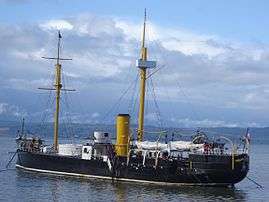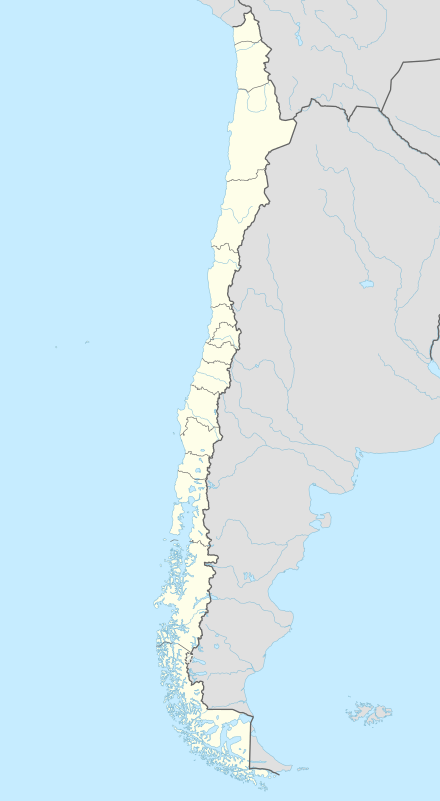Talcahuano
| Talcahuano | |||||
|---|---|---|---|---|---|
| City, Port and Commune | |||||
|
Talcahuano viewed from Michimalonco | |||||
| |||||
| Coordinates (city): 36°43′0″S 073°07′19″W / 36.71667°S 73.12194°WCoordinates: 36°43′0″S 073°07′19″W / 36.71667°S 73.12194°W | |||||
| Country | Chile | ||||
| Region | Biobío | ||||
| Province | Concepción | ||||
| Founded | 1764 | ||||
| Government[1][2] | |||||
| • Type | Municipality | ||||
| • Alcalde | Gastón Saavedra Chandía (Ind.) | ||||
| Area[3] | |||||
| • City, Port and Commune | 92.3 km2 (35.6 sq mi) | ||||
| Elevation | 1 m (3 ft) | ||||
| Population (2012 Census)[3] | |||||
| • City, Port and Commune | 150,499 | ||||
| • Density | 1,600/km2 (4,200/sq mi) | ||||
| • Metro | 250,348 | ||||
| • Urban | 248,964 | ||||
| • Rural | 1,384 | ||||
| Demonym(s) | Talcahuian | ||||
| Sex[3] | |||||
| • Men | 121,778 | ||||
| • Women | 128,570 | ||||
| Time zone | CLT (UTC−4) | ||||
| • Summer (DST) | CLST (UTC−3) | ||||
| Area code(s) | 56 + 41 | ||||
| Website | Official website (Spanish) | ||||
Talcahuano (Spanish pronunciation: [talkaˈwano]) is a port city and commune in the Biobío Region of Chile. It is part of the Greater Concepción conurbation. Talcahuano is located in the south of the Central Zone of Chile.
Geography
Together with ten other municipalities, it forms part of the Concepción Province, which in turn is one of four provinces that forms the VIII Region of Biobío Region.
Demographics
According to the 2002 census of the National Statistics Institute, Talcahuano spans an area of 145.8 km2 (56 sq mi) and has 250,348 inhabitants (121,778 men and 128,570 women). Of these, 248,964 (99.4%) lived in urban areas and 1,384 (0.6%) in rural areas. The population grew by 59.9% (93,766 persons) between the 1992 and 2002 censuses.[3] With a population density of 1,873 inhabitants per square kilometre, it is the seventh most populated city of the country.
History
The official foundation date of Talcahuano is November 5, 1764 when Antonio Guill y Gonzaga declared an official port. However, Talcahuano began to appear in history books as early as 1544 when Genoese captain Juan Bautista Pastene discovered the mouth of the Biobío river while exploring the coast in his ships “San Pedro” and “Santiaguillo”. In 1601 Alonso de Ribera built Fort Talcahueno to defend remaining Spanish settlements near Concepción.
The city is named after an Araucanian chief, Talcahueñu, who inhabited the region at the arrival of the Spanish. In Mapudungun, the language of the indigenous Mapuches, Talcahuano means “Thundering Sky”.
The port was well known to American whaleships of the 19th century. They often put in for fresh water, food, and various forms of entertainment for the crews.
27 February 2010 earthquake

On February 27, 2010 Talcahuano was devastated by the 8.8 magnitude 2010 Chile earthquake and its subsequent tsunami. These back-to-back disasters left 80% of the city's residents homeless. [4] The tsunami is estimated to have been more than 7.5 feet high.[5] After a week, there are only 20 reported deaths, and 18 missing. The city government estimates that it will take 10 years to recover from the quake and tsunami. The local government has been turning away tent aid, as they want to make permanent shelters rather than have permanent tent camps.[6]
Economy
Talcahuano contains Chile's main naval base which is home of the historical relic, the Huáscar, a Peruvian ironclad ship (British-made), which was captured in 1879 during the War of the Pacific. It is also the base of the Chilean submarine fleet and the ASMAR shipyard.
Administration
As a commune, Talcahuano is a third-level administrative division of Chile administered by a municipal council, headed by an alcalde who is directly elected every four years. The 2008-2012 alcalde is Gastón Saavedra Chandía (Ind.).[1][2]
The commune of Talcahuano has seventeen districts, the three most populous being Carriel, San Vicente and San Miguel, which together account for about 46% of the population of the commune.[7] Only two of the districts contain any rural population: Tumbes with 5% rural and Carrie with ½%.[7]
- El Portón
- Valdivieso
- Cerro Fuentes
- La Aduana
- Cerro Buenavista
- Tumbes
- Isla Quiriquina
- San Vicente
- Estadio
- Huachipato
- Estadio Higueras
- San Miguel
- El Arenal
- Carriel
- Las Salinas
- Barranquilla
- Zunico
Within the electoral divisions of Chile, Talcahuano is represented in the Chamber of Deputies by Jorge Ulloa (UDI) and Cristián Campos (PDC) as part of the 43rd electoral district, (together with Hualpén). The commune is represented in the Senate by Alejandro Navarro Brain (MAS) and Hosain Sabag Castillo (PDC) as part of the 12th senatorial constituency (Biobío-Cordillera).
Culture
Sports
Talcahuano entered football history when Ramón Unzaga Asla, a player for the local club Estrella del Mar, invented the famous bicycle kick (also known as "chilena") there in 1914.
The city is home to Club Deportivo Huachipato, a football club in Chile's Primera División, playing at Estadio CAP.
In literature
It featured prominently in Miles Smeeton's book Once Is Enough, a sailor's classic.[8]
It is mentioned by the character Charlie Marlow in Joseph Conrad's book Lord Jim.
A chapter of In Search of the Castaways by Jules Verne is set in its bay.
- Some views of Talcahuano
 Center of Talcahuano
Center of Talcahuano Casino of Talcahuano
Casino of Talcahuano Church of Talcahuano
Church of Talcahuano Monitor Huáscar
Monitor Huáscar View of Port
View of Port
External links
| Wikimedia Commons has media related to Talcahuano. |
- http://www.talcahuano.cl
- Satellite view of Talcahuano (Google Maps)
References
- 1 2 "Asociación Chilena de Municipalidades" (in Spanish). Retrieved 23 February 2011.
- 1 2 "Municipality of Talcahuano" (in Spanish). Retrieved 23 February 2011.
- 1 2 3 4 "National Statistics Institute" (in Spanish). Retrieved 13 December 2010.
- ↑ "Double tragedy for Chile's beach communities". msnbc.com. Retrieved March 1, 2010.
- ↑ Time Magazine, "Chile: Prepared for the Quake but Not the Tsunami", Tim Padget, 1 March 2010 (accessed 4 March 2010)
- ↑ Xinhua, "Destruction seen everywhere in tsunami-hit Chilean port", Alexander Manda, 7 March 2010 (accessed 8 March 2010)
- 1 2 "División Político Administrativa y Censal" (PDF) (in Spanish). Instituto Nacional de Estadísticas (INE). 2007. Archived (PDF) from the original on 8 March 2013.
- ↑ Once Is Enough, by Miles Smeeton. International Marine Publishing, 2003. ISBN 0-07-141431-2




